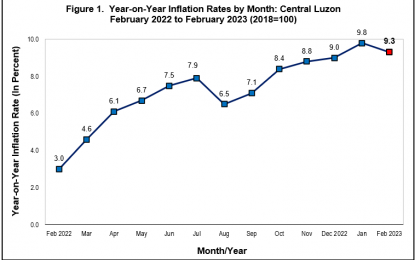
INFLATION EASES. The inflation rate in Central Luzon slowed down to 9.3 percent in February 2023 after five consecutive months of acceleration, according to the latest report of the Philippine Statistics Authority - Regional Statistical Services Office 3 (Central Luzon). The latest figure is 0.5 lower compared to 9.8 percent in January 2023. (Infographic courtesy of PSA)
CITY OF SAN FERNANDO, Pampanga – The inflation rate in Central Luzon eased to 9.3 percent in February after five consecutive months of acceleration.
The latest figure is higher by 6.3 percentage points from 3 percent in February 2022 and 0.5 percentage points lower from 9.8 percent in January 2023.
Central Luzon was fourth among the regions with the highest inflation in February.
Western Visayas recorded the highest inflation at 10.8 percent, followed by Zamboanga Peninsula and Davao Region, both at 9.9 percent.
Eastern Visayas had the lowest inflation at 6.3 percent, followed by the Cordillera Administrative Region at 7.1 percent.
The country’s headline inflation also decelerated to 8.6 percent in February from 8.7 percent in January.
In her report on Wednesday, Philippine Statistics Authority - Regional Statistical Services Office 3 (Central Luzon) Regional Director Arlene Divino said the downtrend in inflation for February was primarily brought about by a lower annual increment in the index of food and non-alcoholic beverages at 10.7 percent from 12 percent last January.
This was followed by the indices of transport at 11.5 percent and housing, water, electricity, gas, and other fuels at 8.4 percent.
The annual growth rate in the regional food index also slowed down to 11 percent in February from 12.6 percent in January.
Divino also said the downward trend in the regional food index can be primarily attributed to lower increments in the annual growth rate of vegetables, tubers, plantains, cooking bananas, and pulses at 33.9 percent, meat and other parts of slaughtered land animals at 4.7 percent, and rice at 2 percent.
However, higher annual increments were recorded for alcoholic beverages and tobacco at 15.5 percent, restaurants and accommodation services at 8.1 percent, personal care and miscellaneous goods and services at 7.6 percent, and clothing and footwear at 7.3 percent.
Al Jonnel Espiritu, the economic development specialist of the National Economic and Development Authority (NEDA) 3, said the government continues to address the impact of inflation, a challenge not only in the region but throughout the country.
Despite the challenges, Espiritu said Central Luzon remains positive in realizing the long-term vision of a "matatag, maginhawa at panatag na buhay para sa lahat (stable, comfortable and secure life for everyone).” (PNA)
